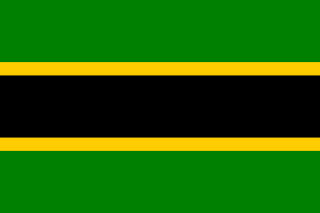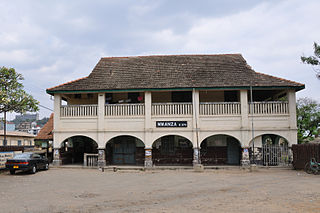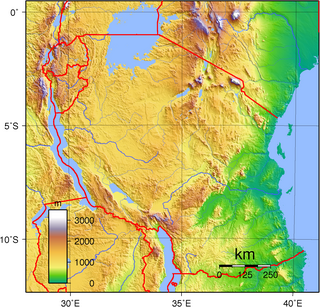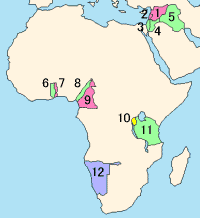The African Great Lakes nation of Tanzania dates formally from 1964, when it was formed out of the union of the much larger mainland territory of Tanganyika and the coastal archipelago of Zanzibar. The former was a colony and part of German East Africa from the 1880s to 1919’s when, under the League of Nations, it became a British mandate. It served as a British military outpost during World War II, providing financial help, munitions, and soldiers. In 1947, Tanganyika became a United Nations Trust Territory under British administration, a status it kept until its independence in 1961. The island of Zanzibar thrived as a trading hub, successively controlled by the Portuguese, the Sultanate of Oman, and then as a British protectorate by the end of the nineteenth century.

Tanganyika was a sovereign state, comprising the mainland part of present-day Tanzania, that existed from 1961 until 1964. It first gained independence from the United Kingdom on 9 December 1961 as a state headed by Queen Elizabeth II before becoming a republic within the Commonwealth of Nations a year later. After signing the Articles of Union on 22 April 1964 and passing an Act of Union on 25 April, Tanganyika officially joined with the People's Republic of Zanzibar and Pemba to form the United Republic of Tanganyika and Zanzibar on Union Day, 26 April 1964. The new state changed its name to the United Republic of Tanzania within a year.

German East Africa (GEA) was a German colony in the African Great Lakes region, which included present-day Burundi, Rwanda, the Tanzania mainland, and the Kionga Triangle, a small region later incorporated into Mozambique. GEA's area was 994,996 square kilometres (384,170 sq mi), which was nearly three times the area of present-day Germany, and double the area of metropolitan Germany then.

The flag of Tanzania consists of a yellow-edged black diagonal band, divided diagonally from the lower hoist-side corner, with a green upper triangle and blue lower triangle. Adopted in 1964 to replace the individual flags of Tanganyika and Zanzibar, it has been the flag of the United Republic of Tanzania since the two states merged that year. The design of the present flag incorporates the elements from the two former flags. It is one of a relatively small number of national flags incorporating a diagonal line, with other examples including the DR Congo, Namibia, Trinidad and Tobago and Brunei.

Chief Mkwavinyika Munyigumba Mwamuyinga, more commonly known as Chief Mkwawa or Sultan Mkwawa, was a Hehe tribal leader in German East Africa in Kalenga, Iringa region(now mostly the mainland part of Tanzania) who opposed the German colonization. The name "Mkwawa" is derived from Mukwava, itself a shortened form of Mukwavinyika, meaning "conqueror of many lands".

Togoland was a German Empire protectorate in West Africa from 1884 to 1914, encompassing what is now the nation of Togo and most of what is now the Volta Region of Ghana, approximately 77,355 km2 in size. During the period known as the "Scramble for Africa", the colony was established in 1884 and was gradually extended inland.
This is a survey of the postage stamps and postal history of the Tanganyika under British mandate.

Ruanda-Urundi was a territory in the African Great Lakes region, once part of German East Africa, which was ruled by Belgium between 1922 and 1962. Occupied by the Belgians during the East African campaign of World War I, the territory was under military occupation from 1916 to 1922 and later became a Belgian-controlled Class-B Mandate under the League of Nations from 1922 to 1945. It was replaced by Trust Territory status under the auspices of the United Nations in the aftermath of World War II and the dissolution of the League but remained under Belgian control. Ruanda-Urundi was granted independence in 1962 as the two separate states of Rwanda and Burundi.
A colonial empire is a collective of territories, either contiguous with the imperial center or located overseas, settled by the population of a certain state and governed by that state.

The East African campaign in World War I was a series of battles and guerrilla actions, which started in German East Africa (GEA) and spread to portions of Portuguese Mozambique, Northern Rhodesia, British East Africa, the Uganda Protectorate, and the Belgian Congo. The campaign all but ended in German East Africa in November 1917 when the Germans entered Portuguese Mozambique and continued the campaign living off Portuguese supplies.
The following is a list of the political history of East Africa.

The Sultanate of Zanzibar, also known as the Zanzibar Sultanate, was a state controlled by the Sultan of Zanzibar, in place between 1856 and 1964. The Sultanate's territories varied over time, and at their greatest extent spanned all of present-day Kenya and the Zanzibar Archipelago of the Swahili Coast. After a decline, the state controlled only Zanzibar and a 16-kilometre-wide (10 mi) strip along the Kenyan coast, with the interior of Kenya controlled by the British Kenya Colony.

The German colonization of Africa took place during two distinct periods. In the 1680s, the Margraviate of Brandenburg, then leading the broader realm of Brandenburg-Prussia, pursued limited imperial efforts in West Africa. The Brandenburg African Company was chartered in 1682 and established two small settlements on the Gold Coast of what is today Ghana. Five years later, a treaty with the king of Arguin in Mauritania established a protectorate over that island, and Brandenburg occupied an abandoned fort originally constructed there by Portugal. Brandenburg — after 1701, the Kingdom of Prussia — pursued these colonial efforts until 1721, when Arguin was captured by the French and the Gold Coast settlements were sold to the Dutch Republic.

The Rugby Football Union of East Africa (RFUEA) is an umbrella union for the Kenya Rugby Football Union, Tanzania Rugby Football Union and Uganda Rugby Football Union. It owes its existence to the fact that, prior to independence, Kenya, Tanzania and Uganda were either a protectorate or mandate of the British Empire. It now has little to do with the direct administration of the modern game but it continues to exist in order to promote and support the game in the three countries, to facilitate club competition between the three unions and to administer the RFUEA Ground and the East Africa rugby union team.

French Cameroon or French Cameroons was a League of Nations Mandate territory in Central Africa. It now forms part of the independent country of Cameroon.

The history of rail transport in Tanzania began in the late nineteenth century.

Tanzania Mainland refers to the part of Tanzania on the continent of Africa; excluding the islands of Zanzibar. It corresponds with the area of the former country of Tanganyika.

Albrecht von Rechenberg, Albrecht Freiherr von Rechenberg or Georg Albrecht Julius Heinrich Friedrich Carl Ferdinand Maria Freiherr von Rechenberg was a German jurist, diplomat and a politician who served as Governor of German East Africa and as a member of the Imperial Diet (German:Reichstag).

















